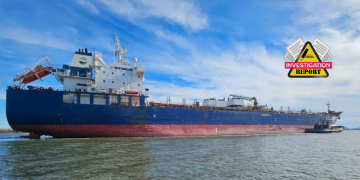Inert gas is an asphyxiant due to the low oxygen content and contains low oxygen levels for life support, CO2, CO, NOx, SOx and traces of other substances. In addition, some of its components (e.g. carbon monoxide, sulphur dioxide, etc.) are toxic. Thus, all personnel onboard need to be aware of potential hazards which may arise due to leakage of inert gas and take precautions.
Why inert gas is important onboard
An inert gas system is a crucial system for safety against explosion onboard. Namely, inert gas systems are essential on ships that frequently carry hazardous cargoes with some of the most dangerous being those that are explosive or flammable. This important integrated system can be through as a separate inert gas plant or flue gas produced by ship’s boiler. Use of inert gas systems in dry cargo vessels is voluntary but for oil and chemical tankers it is compulsory under SOLAS and more specifically chapter 15 of the Fire Safety Code.
Health hazards when inhaling inert gas
The health hazards related to flue and inert gases are oxygen deficiency and health hazards due to exposure to combustion gases; carbon monoxide (CO); and sulphur dioxide (SO2). Inhalation of the inert gas may cause nervous system disorder, difficulty in breathing, oxygen deficiency and if prolonged can lead to death.
Carbon monoxide (CO) is a colourless, odourless tasteless gas which provides no warning of inhalation. Inhalation produces central nervous system depression and may be fatal. Sulphur dioxide (SO2) is a strong, sulphurous smelling gas which is irritating to the eyes and respiratory track at higher concentrations. Inhalation produces chest pains, severe breathing difficulty and may prove fatal. If CO or SO2 is inhaled, remove the victim from the contaminated area, administer oxygen and, if necessary, resuscitate. In any case, seek for medical attention or advice the soonest possible.
First Aid
Provide fresh air as first aid and then if necessary, start artificial respiration. In the case of eye contact with flue or inert gas, flush the eyes with fresh water for at least 15 minutes occasionally, lifting the upper and lower eyelids. If necessary, seek medical attention.
Precautions
Entry into an inert space is normally not allowed. In the exceptional case, when entrance is absolutely necessary, do not enter the space without the aid of a Self-Contained Breathing Apparatus (SCBA) and special suit. If the skin or eyes come into contact with combustion deposits associated with inert gas, coveralls, chemical resistant gloves and goggles shall be worn. Do not eat, drink or smoke in areas where combustion deposits are present. Wash hands before eating, drinking or smoking. Wash contaminated clothing prior re-use.
Inert gas does not affect hydrocarbon or toxic gas levels in a tank atmosphere. Dilution of an inert atmosphere when vented may result in pockets of gas which are within the flammable range and which may be toxic. When gauging or sampling operations are taking place, personnel should avoid standing in the path of vented gas. Whenever a tank is kept inert at positive pressure, personnel should be alerted to the potential hazards of this pressure. Pressure should be reduced prior to opening tank lids, ullage ports, tank cleaning hatches, etc.





























































